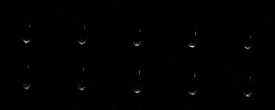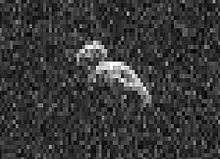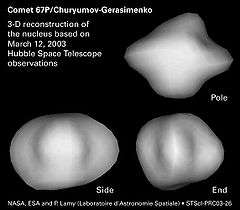(410777) 2009 FD
|
Arecibo Observatory radar images of near-Earth asteroid 2009 FD | |||||||||
| Discovery[1][2][3] | |||||||||
|---|---|---|---|---|---|---|---|---|---|
| Discovered by | Spacewatch (691) | ||||||||
| Discovery date | 24 February 2009 | ||||||||
| Designations | |||||||||
| MPC designation | (410777) 2009 FD | ||||||||
| Apollo NEO[4] | |||||||||
| Orbital characteristics[4] | |||||||||
| Epoch 26 March 2013 (JD 2456377.5) | |||||||||
| Uncertainty parameter 0 | |||||||||
| Observation arc | 2471 days (6.77 yr) | ||||||||
| Aphelion | 1.7359 AU (259.69 Gm) | ||||||||
| Perihelion | 0.58960 AU (88.203 Gm) | ||||||||
| 1.1627 AU (173.94 Gm) | |||||||||
| Eccentricity | 0.49293 | ||||||||
| 1.25 yr (457.96 d) | |||||||||
| 20.774° | |||||||||
| 0° 47m 9.96s / day | |||||||||
| Inclination | 3.1372° | ||||||||
| 9.5574° | |||||||||
| 281.22° | |||||||||
| Earth MOID | 0.00248182 AU (371,275 km) | ||||||||
| Jupiter MOID | 3.45524 AU (516.897 Gm) | ||||||||
| Jupiter Tisserand parameter | 5.296 | ||||||||
| Proper orbital elements[4][5] | |||||||||
Proper eccentricity | 0.49345 | ||||||||
Proper inclination | 2.583° | ||||||||
Proper mean motion | 286.77 deg / yr | ||||||||
Proper orbital period |
1.25536 yr (458.521 d) | ||||||||
| Physical characteristics | |||||||||
| Dimensions |
472 m (1,550 ft)[4][6][7] Primary: 120–180 m Secondary: 60–120 m[8] | ||||||||
Mean radius | 0.236 km | ||||||||
| Mass | 8.3×1010 kg (assumed)[7] | ||||||||
Mean density | 1.89 g/cm³[9] | ||||||||
Equatorial surface gravity | 0.2489 mm/s²[9] | ||||||||
Equatorial escape velocity | 0.4846 m/s[9] | ||||||||
| 4.0 h (0.17 d)[4] | |||||||||
| 0.01[4] | |||||||||
| |||||||||
| C[10] | |||||||||
| 22.1[4] | |||||||||
|
| |||||||||
(410777) 2009 FD (also written as 2009 FD) is a binary[8][11] Apollo asteroid[4] (a class of near-Earth asteroid) with an orbit that places it at risk of a possible future collision with Earth in 2185. It has the third highest impact threat of all known asteroids on the Palermo Technical Impact Hazard Scale based on its estimated diameter of 470 meters, kinetic yield, impact probability, and time interval.[12]
(410777) 2009 FD was initially announced as discovered on 16 March 2009 by La Sagra Sky Survey.[1] Because there were previous observations found in images taken by the Spacewatch survey some 3 weeks prior, on 24 February 2009, the Minor Planet Center assigned the discovery credit to Spacewatch under the discovery assignment rules.[2][3] (410777) 2009 FD made a close pass to Earth on 27 March 2009 at a distance of 0.004172 AU (624,100 km; 387,800 mi)[13][14] and another on 24 October 2010 at 0.0702 AU.[13] (410777) 2009 FD was recovered at apparent magnitude 23[note 1] on 30 November 2013 by Cerro Paranal Observatory,[3] several months before the close approach of April 2014 when it passed 0.1 AU from Earth.[13] It brightened to roughly apparent magnitude 19.3 around mid-March 2014.[15] One radar Doppler observation of (410777) 2009 FD was made in 2014.[4] The October–November 2015 Earth approach will be studied by the Goldstone Deep Space Network.[16]
NASA's Near Earth Program originally estimated its size to be 130 metres in diameter based on an assumed albedo of 0.15.[17] This gave it an estimated mass of around 2,800,000 tonnes.[17] But work by Amy Mainzer using NEOWISE data in 2014 showed that it could be as large as 472 metres with an albedo as low as 0.01.[4][6] Because (410777) 2009 FD (K09F00D) was only detected in two (W1+W2) of the four wavelengths the suspected NEOWISE diameter is more of an upper limit.[6] Radar observations in 2015 showed it to be a binary asteroid.[8] The primary is 120–180 meters in diameter and the secondary is 60–120 meters in diameter.[8]
The JPL Small-Body Database shows that (410777) 2009 FD will make two very close approaches in the late 22nd century, with the approach of 29 March 2185 currently having a 1 in 385 chance of impacting Earth.[7] The nominal 2185 Earth approach distance is 0.009 AU (1,300,000 km; 840,000 mi).[13] Orbit determination for 2190 is complicated by the 2185 close approach.[13] The precise distance that it will pass from Earth and the Moon on 29 March 2185 will determine the 30 March 2190 distance. (410777) 2009 FD should pass closer to the Moon than Earth on 29 March 2185.[13] An impact by (410777) 2009 FD would cause severe devastation to a large region or tsunamis of significant size.[18] Due to (410777) 2009 FD's size, and its interactions with Mars and Venus, which increase its orbital uncertainty over time, it is rated −0.40 on the Palermo Scale, placing it higher on the Sentry Risk Table than any other known object.[12]
Past Earth-impact estimates
In January 2011, near-Earth asteroid (410777) 2009 FD (with observations through 7 December 2010) was listed on the JPL Sentry Risk Table with a 1 in 435 chance of impacting Earth on 29 March 2185.[17] In 2014 (with observations through 5 February 2014 creating an observation arc of 1807 days) the potential 2185 impact was ruled out.[19] Using the 2014 observations, the Yarkovsky effect has become more significant than the position uncertainties.[5][10][20] The Yarkovsky effect has resulted in the 2185 virtual impactor returning.
See also
- List of asteroid close approaches to Earth, for other close approaches
- Potentially hazardous object
Notes
- ↑ At an apparent magnitude of 23, (410777) 2009 FD was roughly 4 million times fainter than can be seen with the naked eye.
Math:
References
- 1 2 "MPEC 2009-F09 : 2009 FD". IAU Minor Planet Center. 2009-03-17. Retrieved 2013-01-09. (K09F00D)
- 1 2 "MPEC 2010-U20 : Editorial Notice". IAU Minor Planet Center. 2010-10-19. Retrieved 2014-12-29.
- 1 2 3 "2009 FD Orbit". IAU Minor Planet Center. Retrieved 2013-12-17.
- 1 2 3 4 5 6 7 8 9 10 "JPL Small-Body Database Browser: (2009 FD)" (last observation: 2014-04-07; arc: 5.11 years). Jet Propulsion Laboratory. Retrieved 11 April 2016.
- 1 2 "(410777) 2009FD". NEODyS (Near Earth Objects – Dynamic Site). Retrieved 2014-05-01. (2.64e-3 = 1 in 379 chance)
- 1 2 3 Mainzer, Amy; Bauer, J.; Grav, T.; Masiero, J.; Cutri, R. M.; Wright, E.; Nugent, C. R.; Stevenson, R.; Clyne, E.; Cukrov, G.; Masci, F. (2014). "The Population of Tiny Near-Earth Objects Observed by NEOWISE". The Astrophysical Journal. 784 (2): 110. arXiv:1310.2980
 . Bibcode:2014ApJ...784..110M. doi:10.1088/0004-637X/784/2/110. (listed as K09F00D)
. Bibcode:2014ApJ...784..110M. doi:10.1088/0004-637X/784/2/110. (listed as K09F00D) - 1 2 3 "Earth Impact Risk Summary: 2009 FD". NASA/JPL Near-Earth Object Program Office. Retrieved 2014-05-01.
- 1 2 3 4 "(410777) 2009 FD". Central Bureau for Astronomical Telegrams. 2015-11-19. Retrieved 2015-11-21.
- 1 2 3 4 "Planetary Habitability Calculators". Planetary Habitability Laboratory. University of Puerto Rico at Arecibo. Retrieved 28 November 2015.
- 1 2 Spoto, F.; Milani, A.; Farnocchia, D.; Chesley, S. R.; Micheli; Valsecchi; Perna; Hainaut (2014). "Non-gravitational Perturbations and Virtual Impactors: the case of asteroid 2009 FD". Astronomy & Astrophysics. 572: A100. arXiv:1408.0736
 . Bibcode:2014A&A...572A.100S. doi:10.1051/0004-6361/201424743.
. Bibcode:2014A&A...572A.100S. doi:10.1051/0004-6361/201424743. - ↑ http://www.naic.edu/~pradar/
- 1 2 Sentry Risk Table Archived April 2, 2003, at the Wayback Machine.
- 1 2 3 4 5 6 "JPL Close-Approach Data: (2009 FD)" (last observation: 2014-04-07; arc: 5.11 years). Retrieved 2014-05-01.
- ↑ Near Earth Asteroid 2009 FD - whilst you were sleeping! (ice in space)
- ↑ "2009 FD Ephemerides for 1 April 2014". NEODyS (Near Earth Objects – Dynamic Site). Retrieved 2013-12-17.
- ↑ Dr. Lance A. M. Benner (2014-03-17). "Goldstone Asteroid Schedule". NASA/JPL Asteroid Radar Research. Retrieved 2014-03-21.
- 1 2 3 "Earth Impact Risk Summary: 2009 FD (arc=650 days)" (2011-01-11 computed on Dec 14, 2010). Wayback Machine: JPL. Archived from the original on January 11, 2011. Retrieved 2014-02-14. (2.3e-03 = 1 in 435 chance)
- ↑ How a Near-Earth Object Impact Might Affect Society, 9 January 2003, Clark R. Chapman, SwRI, Boulder CO USA
- ↑ "Earth Impact Risk Summary: 2009 FD (arc=1807 days)" (2014-02-10 computed on Feb 07, 2014). Wayback Machine: JPL. Archived from the original on February 10, 2014. Retrieved 2014-05-01.
- ↑ "Sentry Notes". NASA/JPL Near-Earth Object Program Office. Retrieved 2014-05-01.
External links
- ESA/ESO Collaboration Successfully Tracks Its First Potentially Threatening Near-Earth Object (ESO 21 January 2014)
- (410777) 2009 FD at the JPL Small-Body Database



